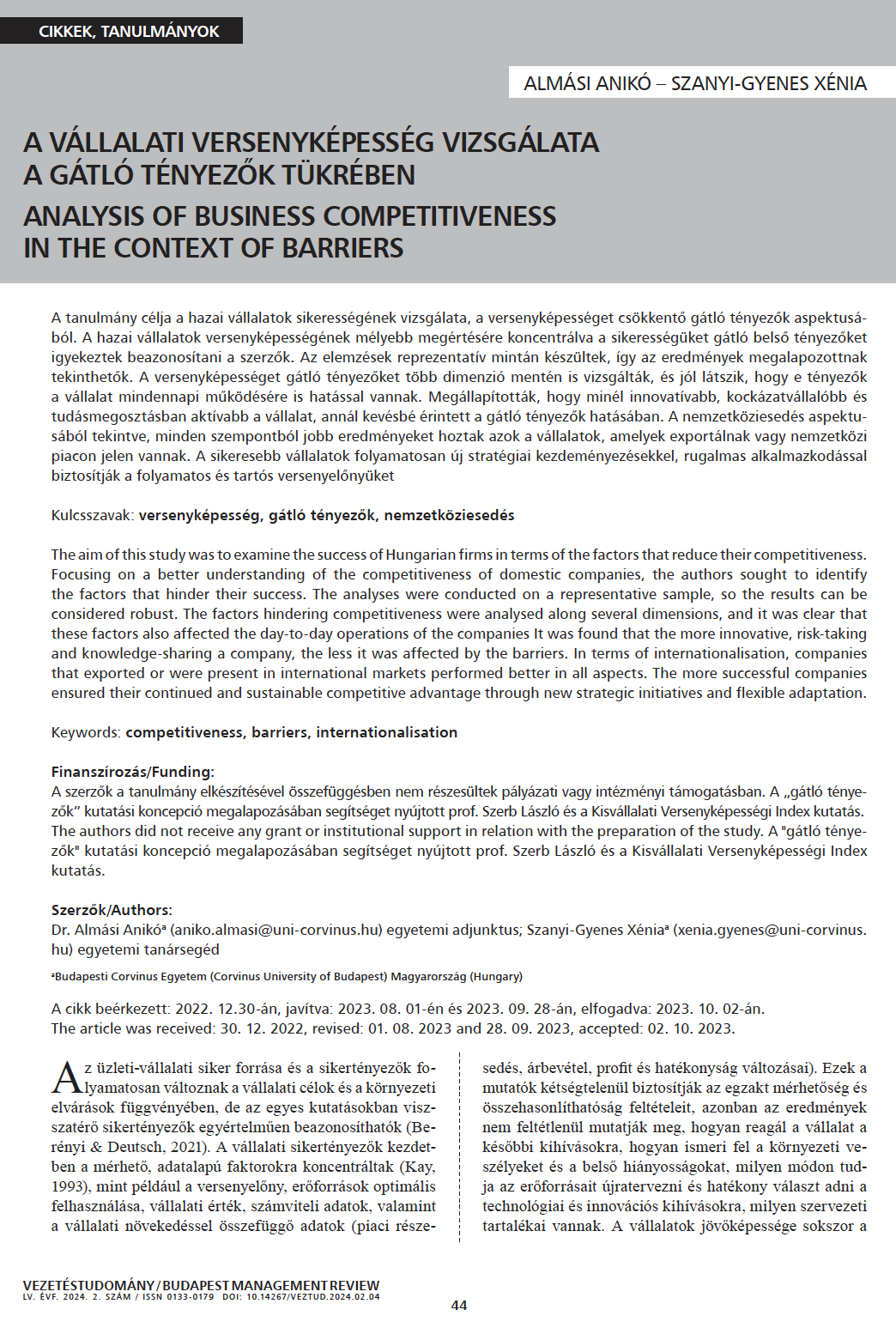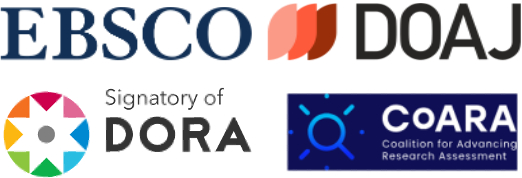A vállalati versenyképesség vizsgálata a gátló tényezők tükrében
DOI:
https://doi.org/10.14267/VEZTUD.2024.02.04Kulcsszavak:
versenyképesség, gátló tényezők, nemzetköziesedésAbsztrakt
A tanulmány célja a hazai vállalatok sikerességének vizsgálata, a versenyképességet csökkentő gátló tényezők aspektusából. A hazai vállalatok versenyképességének mélyebb megértésére koncentrálva a sikerességüket gátló belső tényezőket igyekeztek beazonosítani a szerzők. Az elemzések reprezentatív mintán készültek, így az eredmények megalapozottnak tekinthetők. A versenyképességet gátló tényezőket több dimenzió mentén is vizsgálták, és jól látszik, hogy e tényezők a vállalat mindennapi működésére is hatással vannak. Megállapították, hogy minél innovatívabb, kockázatvállalóbb és tudásmegosztásban aktívabb a vállalat, annál kevésbé érintett a gátló tényezők hatásában. A nemzetköziesedés aspektusából tekintve, minden szempontból jobb eredményeket hoztak azok a vállalatok, amelyek exportálnak vagy nemzetközi piacon jelen vannak. A sikeresebb vállalatok folyamatosan új stratégiai kezdeményezésekkel, rugalmas alkalmazkodással biztosítják a folyamatos és tartós versenyelőnyüket.
Letöltések
Hivatkozások
Ábel, I. & Czakó, E. (szerk.) (2013). Az exportsiker nyomában. Alinea Kiadó.
Acs, Z. & Audretsch, D.B. (1988). Innovation in large and small firms: an empirical analysis. The American Economic Review, 78(4), 678-690. https://www.jstor.org/stable/1811167
Acs, Z., Arenius, P., Hay, M. & Minniti, M. (2005). Global Entrepreneurship Monitor 2004. Executive Report. Babson College; London Business School. https://www.gemconsortium.org/report/gem-2004-global-report
Almási, A. (2019). A szervezeti tényezők szerepe a magyarországi KKV-szektor sikerességében. Competitio, 18(1-2), 108-125. https://doi.org/10.21845/comp/2019/1-2/4
Antalóczy, K. & Sass, M. (2011). Kis- és közepes méretű vállalatok nemzetköziesedése – elmélet és empíria. Külgazdaság, 55(szept-okt), 22-33. https://penzugykutato.hu/sites/default/files/Antaloczy%20-%20Sass%20-%20Kis-%20es%20kozepes%20meretu%20vallalatok%20nemzetkoziesedese.pdf
Barney, J.B. (2001). Resource-based theories of competitive advantage: A ten-year retrospective on the resource- based view. Journal of Management, 27(6), 643-650. https://doi.org/10.1177/014920630102700602
Bácsi, K., Szőtsné, K.K., Takács, S., & Toarniczky A. (2006). Emberi erőforrás menedzsment, leadership és versenyképesség: Versenyben a világgal 2004-2006. Gazdasági versenyképességünk vállalati nézőpontból című kutatás. Versenyképességi Kutatások műhelytanulmány sorozat, 39. sz. műhelytanulmány. Budapesti Corvinus Egyetem. https://www.uni-corvinus.hu/contents/uploads/2022/03/39_mht_Bacsi_Kovats_Takacs.pdf
Bánfi, T., Boros, Á. & Lovas, A. (2012). Vállalati vezetők innovációs érzékenysége, szemlélete és szándékaik – egy felmérés tapasztalatai. Vezetéstudomány, 43(3), 2-18. https://unipub.lib.uni-corvinus.hu/587/1/vt_2012n3p2.pdf
Békés, G. & Muraközy, B. (2012). Magyar gazellák. Közgazdasági Szemle, 59(3), 233-262. http://www.kszemle.hu/tartalom/cikk.php?id=1295
Békés, G., Halpern, L. & Muraközy, B. (2013). Külkereskedelem és a vállalatok közötti különbségek. Közgazdasági Szemle, 60(1), 1-24. http://real.mtak.hu/id/eprint/6391
Berényi, L. & Deutsch, N. (2021). Vállalati sikertényezők fontosságának értékelése. In Karlovitz, J.T. (szerk.), Az ember és gazdagsága egészséges és biztonságos környezetben (pp. 46-59). International Research Institute. http://www.irisro.org/tarstud2021junius/11Berenyi-Laszlo-DeutschNikolett.pdf
Bódi-Schubert, A. (2012). A siker szerepe és jelentése a vevő- beszállító kapcsolatban. Vezetéstudomány, 43(11), 46-59. https://unipub.lib.uni-corvinus.hu/1032/1/vt_2012n11p46.pdf
Cetindamar, D. & Kilitcioglu, H. (2013). Measuring the competitiveness of a firm for an award system. Competitiveness Review, 23(1), 7-22. http://dx.doi.org/10.1108/10595421311296597
Chikán, A. & Czakó, E. (2009). Versenyben a világgal: Vállalataink versenyképessége az új évezred küszöbén. Akadémiai Kiadó.
Chikán, A., Czakó, E., Demeter, K., & Losonci, D. (2019). Versenyben a világgal? – A mikrogazdasági versenyképességi kutatások eredményei, 1995-2018. Vezetéstudomány, 50(12), 16-31. https://doi.org/10.14267/VEZTUD.2019.12.03
Chilton, M.A. & Bloodgodd, J.M. (2014). Knowledge management and competitive advantage: issues and potential solutions. IGI Global.
Czakó, E. (2000). Versenyképesség iparágak szintjén – a globalizáció tükrében (Doktori értekezés). BKÁE Vállalatgazdaságtan Tanszék, Budapest. http://phd.lib.uni-corvinus.hu/162/1/czako_erzsebet_hun.pdf
Czakó, E. & Chikán, A. (2007). Gazdasági versenyképességünk vállalati szempontból 2004- 2006. Vezetéstudomány, 38(5), 2-8. https://unipub.lib.uni-corvinus.hu/3960/1/vt2007n5p02-08.pdf
Czakó, E., Juhász, P. & Reszegi, L. (2016). Contrasting Methods: An explorative Investigation on Firm-Level Export Competitiveness Based on Qualitative and Quantitative Research Findings. In P. Trąpczyński, Ł. Puślecki, & M. Jarosiński (eds), Competitiveness of CEE Economies and Businesses (pp. 133-148). Springer. https://doi.org/10.1007/978-3-319-39654-5_7
Czeglédi, P. (2012). Mechanism of Success: How Do Macroeconomic Models explain the Industrial Revolution? In Czeglédi P., & Kapás J. (eds.), Institutions and the Industrial Revolution (pp. 7-34). Competitio Books. https://web.unideb.hu/jkapas/pdf/Kapas-Czegledi_Institutions%20and%20the%20Industrial%20Revolution.pdf
Csákné Filep, J., Radácsi L., & Timár G. (2020). A magyar startup-vállalkozások túlélését és növekedését befolyásoló tényezők: Szakértői interjúk tapasztalatai. Vezetéstudomány, 51(1), 16-31. https://doi.org/10.14267/VEZTUD.2020.01.02
Csillag, S., Csizmadia, P., Hidegh, A.L., & Szászvári, K. (2020). A kicsi szép? Tanulás és fejlődés a kisvállalkozásokban. Vezetéstudomány, 51(1), 2-15. https://doi.org/10.14267/VEZTUD.2020.01.01
Dabić, M., Maley, J., Dana, L.P., Novak, I., Pellegrini, M.M., & Caputo, A. (2020). Pathways of SME internationalization: a bibliometric and systematic review. Small Business Economics, 55, 705–725. https://doi.org/10.1007/s11187-019-00181-6
de Vries, K. M. (2006). The Leader on the Couch. A clinical approach to changing people and organizations. Wiley.
Dobák, M., Hortoványi, L., & Szabó, Zs.R. (2012). A sikeres növekedés és innováció feltételei. Vezetéstudomány, 43(12), 40-48. https://doi.org/10.14267/VEZTUD.2012.12.05
Doub, M. & Edgcomb, E. (2005). Bridges to success: promising strategies for microenterprise business growth in the United States. The Aspen Institute. https://www.aspeninstitute.org/wp-content/uploads/2017/07/Bridges-to-Success.pdf
Drucker, P.F. (1988). The coming of the new organization. Harvard Business Review, 66(1), 45-53. https://hbr.org/1988/01/the-coming-of-the-new-organization
Dyer, L., & Reeves, T. (1995). Human resource strategies and firm performance: What do we know and where do we need to go? International Journal of Human Resource Management, 6(3), 656–670. https://doi.org/10.1080/09585199500000041
Dvoulety, O., & Blazková, I. (2021). Determinants of competitiveness of the Czech SMEs: findings from the global competitiveness project. Competitiveness Review: An International Business Journal, 31(3), 361- 378. https://doi.org/10.1108/CR-01-2020-0007
Elliason, K., Hansson, P., & Lindvert, M. (2012). Do firms learn by exporting or learn to export? Evidences from SMEs. Small Business Economics, 39(2), 453-472. https://doi.org/10.1007/s11187-010-9314-3
Eriksson, T., Heikkilä, M. & Nummela, N. (2022). Business model innovation for resilient international growth. Small Enterprise Research, 29(3), 205-226. https://doi.org/10.1080/13215906.2022.2092890
European Commissionn (2023). European Innovation Scoreboard 2023 and Regional Innovation Scoreboard. https://ec.europa.eu/research-and-innovation/en/statistics/performance-indicators/european-innovation-scoreboard/eis
Eurostat (2018). Community Innovation Survey 2018 (CIS2018). https://ec.europa.eu/eurostat/cache/metadata/en/inn_cis11_esms.htm
Farkas, G., Málovics, É., & Kincsesné Vajda, B. (2017). Az innovatív vállalkozói karakter nyomában. In Vilmányi M., & Kazár K. (szerk.), Menedzsment innovációk az üzleti és a nonbusiness szférákban (pp. 65-79). SZTE Gazdaságtudományi Kar. http://acta.bibl.u-szeged.hu/57389/
Festinger, L. (2000). A kognitív disszonancia elmélete. Osiris Kiadó.
Fletcher, M., Harris, S., & Riches, G. (2013). Internationalization Knowledge: What, Why, Where and When? Journal of International Marketing, 21(3), 47-71. https://doi.org/10.1509/jim.12.0121
Fourné, S.P.L., Zschoche, M., Schwens, C., & Kotha, R. (2023). Multinational family firms’ internationalization depth and breadth following the global financial crisis. Journal of World Business, 58(3),101428. https://doi.org/10.1016/j.jwb.2023.101428
Galy, E. & Sauceda, M.J. (2014). Post-implementation practices of ERP systems and their relationship to financial performance. Information and Innovation, 13(1), 310-319. https://doi.org/10.1016/j.im.2014.02.002
Grant, D., Hardy, C., Oswick, C., & Putnam, L. (2004). Introduction: Organizational discourse: Exploring the field. In Grant, D., Hardy, C., Oswick, C., & Putnam, L. (eds.), Organizational discourse (pp. 1-36). Sage. https://doi.org/10.4135/9781848608122.n1
Handy, C. (1986). Szervezetek irányítása a változó világban. Mezőgazdasági Könyvkiadó.
Hámori, B., & Szabó, K. (2012). Innovációs verseny: Esélyek és korlátok. Aula Kiadó.
Hennart, J.F., Majocchi, A., & Hagen, B. (2021). What’s so special about born globals, their entrepreneurs or their business model? Journal of International Business Studies, 52(9), 1665-1694. https://doi.org/10.1057/s41267-021-00427-0
Hurta, H. (2013). A versengő és a kooperatív vezetői attitűd a magyar kis- és középvállalkozások körében (Doktori értekezés). Szent István Egyetem. http://archivum.szie.hu/?docId=13471
Inzelt, A., & Szerb, L. (2003). Innovációs aktivitás vizsgálata ökonometriai módszerek alkalmazásával. Közgazdasági Szemle, 50(11), 1002-1021. https://www.kszemle.hu/tartalom/cikk.php?id=649
Jenkins, A.S., Wilund, J., & Brundin, E. (2014). Individual responses to firm failure: Appraisals, grief and the influence of prior failure experience. Journal of Business Venturing, 29(1), 17-33. https://doi.org/10.1016/j.jbusvent.2012.10.006
Juergensenn, J., Guimón, J., & Narula, R. (2020). European SMEs amidst the COVID-19 crisis: assessing impact and policy responses. Journal of Industrial and Business Economics, 47(3), 499-510. https://doi.org/10.1007/s40812-020-00169-4
Kállay, L. & Lengyel, I. (2007). A magyar kis- és középvállalatok nemzetköziesedése. Vállalkozás és Innováció, 2(1), 54-76.
Kay, J. (1993). Foundations of Corporate Success. Oxford University Press.
Kaplan, R.S., & Norton, D.P. (2000). The strategy-focused organization: how balanced scorecard companies thrive in the new business environment. Harvard Business School Press.
Kazai Ónodi, A. (2014). Export performance clusters of the Hungarian enterprises: what factors are behind the successful export activities? Entrepreneurial Business and Economics Review, 2(4), 9-29. https://doi.org/10.15678/EBER.2014.020402
Khelil, N. (2016). The many faces of entrepreneurial failure: Insights from an empirical taxonomy. Journal of Business Venturing, 31(1), 72-94. https://doi.org/10.1016/j.jbusvent.2015.08.001
Kőműves, Zs., Poór, J., & Karácsony, P. (2022). Vezetői motiváció a munkaerő-megtartás szolgálatában, különös tekintettel a dél-dunántúli régió kis- és középvállalkozásaira. Marketing & Menedzsment, 56(2), 72-82. https://doi.org/10.15170/MM.2022.56.02.07.
Krugman, P. (1994). Competitiveness: a dangerous obsession. Foreign Affairs, 73(2), 28-44. https://doi.org/10.2307/20045917
Kyndt, E., & Baert, H. (2015). Entrepreneurial competences: Assesment and predictive value for entrepreneurship. Journal of Vocational Behaviour, 90, 13-25. https://doi.org/10.1016/j.jvb.2015.07.002
Major, I. (2002). Miért (nem) sikeresek a magyar középvállalatok? Közgazdasági Szemle, 49(12), 993-1014.
Marciniak, R. (ed.) (2022). A Jövő Szervezete és Vezetése. Kutatási Jelentés. Budapesti Corvinus Egyetem. https://doi.org/10.14267/978-963-503-929-6
Matzler, K., Bailom, F., Anschober, M., & Richardson, S. (2010). Sustaining corporate success: what drives the top performers? Journal of Business Strategy, 31(5), 4-13. https://doi.org/10.1108/02756661011076273
March, J.G. (2005). Szervezeti tanulás és döntéshozatal. Alinea Kiadó.
Maslow, A. (2003). A lét pszichológiája felé. Ursus Libri.
Némethné Gál, A. (2010). A kis- és középvállalatok versenyképessége – egy lehetséges elemzési keretrendszer. Közgazdasági Szemle, 57(Febr.),181-193. https://efolyoirat.oszk.hu/00000/00017/00167/pdf/5_nemethne.pdf
Ónodi, A., & Répáczky, R. (2022). A menedzsment szerepe az innovatív vállalatok sikerében. Vezetéstudomány, 53(10), 2-14. https://doi.org/10.14267/VEZTUD.2022.10.01
Pálinkás, J. (2006). Vállalati jövőkép – küldetés – kockázat. Vezetéstudomány, 37(3), 48-54. https://doi.org/10.14267/VEZTUD.2006.03.05
Papadaki, E., & Chami, B. (2002). Growth Determinants of Micro-Businesses in Canada. Small Business Policy Branch. Industry Canada. https://sites.telfer.uottawa.ca/womensenterprise/files/2014/06/Industry-Canada-Growth-Determinants-of-Micro-Businesses-in-Canada-2002_Eng.pdf
Pavitt, K. (1991). Key characteristics of the large innovating firm. British Journal of Management, 2(1), 41-50. https://doi.org/10.1111/j.1467-8551.1991.tb00014.x
Porter, M.E. (1991). Towards a dynamic theory of strategy. Strategic Management Journal, 12(52), 95-117. https://doi.org/10.1002/smj.4250121008
Prahalad, C.K., & Hamel, G. (1990). The core competence of the corporation. Harvard Business Review, (May – June), 79-90. https://hbr.org/1990/05/the-core-competence-of-the-corporation
Peters, T.J., & Waterman, R.H. (1986). A siker nyomában. Kossuth/KJK
Repisky, M. (2023). A Categorization of the Consequences of Entrepreneurial Failure. Vezetéstudomány/Budapest Management Review, 54(5), 2-17. https://doi.org/10.14267/VEZTUD.2023.05.01
Rideg, A. (2017). A versenyképesség, a vállalati kompetenciák és a pénzügyi teljesítmény összefüggéseinek elemzése a magyar KKV-szektorban (Doktori értekezés). Pécsi Tudományegyetem Gazdálkodástani Doktori Iskola. https://pea.lib.pte.hu/bitstream/handle/pea/23354/rideg-andras-tezis-hun-2018.pdf
Schlichter, J., Klyver, K., & Haug, A. (2018). The moderating effect of ERP system complexity on the growth-profitability relationship in young SMEs. Journal of Small Business Management, 59(4), 1-19. https://doi.org/10.1111/jsbm.12502
Schultz, M., & Maguire, S. (2013). Identity in and around organisations. The European Business Review, (May- June), 8-12. http://majkenschultz.com/wp-content/uploads/sites/10485/2016/03/Identity-In-and-Around-Organisations-TEBR-May-Jun-2013.pdf
Shepherd, D.A. (2003). Learning from business failure: propositions of grief recovery for the self-employed. Academy of Management Review, 28(2), 318-328. https://doi.org/10.2307/30040715
Somogyi, M. (2009). A vállalati versenyképesség modellje (VVM) mint a vállalati versenyképesség mérésének új módszere (Doktori értekezés). Miskolci Egyetem. http://midra.uni-miskolc.hu/document/5634/1509.pdf
Stocker, M. (2016). Local heroes in Hungary. In P. Trąpczyński, Ł. Puślecki, & M. Jarosiński (Eds.), Competitiveness of CEE. Economies and Businesses (pp. 211- 223). Springer. https://doi.org/10.1007/978-3-319-39654-5_11
Stocker, M. (2019). Survival, growth, and performance of Hungarian international new ventures. Society and Economy, 41(1), 47-64. https://doi.org/10.1556/204.2019.41.1.4
Stocker, M., & Várkonyi, L. (2022). Impact of market orientation on competitiveness: Analysis of internationalized medium-sized and large enterprises. Entrepreneurial Business and Economics Review, 10(1), 81-95. https://doi.org/10.15678/EBER.2022.100106
Storey, J., & Salaman, G. (2010). Vezetői dilemmák. Akadémiai Kiadó.
Szanyi-Gyenes, X. & Almási, A. (2021). A vezető szerepe a kis- és közepes vállalkozások sikerességében. Vezetéstudomány, 52(3), 40-52. https://doi.ord/10.14267/VEZTUD.2021.03.04
Szanyi-Gyenes, X. & Almási, A. (2023). Top executives on competitiveness: survey of digitalization and internationalization in Hungarian companies. Acta Polytechnika Hungarica, 20(9), 43-62. https://doi.org/10.12700/APH.20.9.2023.9.3
Szerb L. (2011). Vállalkozások, vállalkozási elméletek, vállalkozások mérése és a Globális Vállalkozói és Fejlődési Index (Doktori értekezés). PTE. http://rreal-d.mtak.hu/378/
Szerb, L., Márkus, G., & Csapi, V. (2014). Versenyképesség és nemzetköziesedés a magyar kisvállalatok körében a 2010-es években. Külgazdaság, 58(Nov-Dec), 53-57. https://kulgazdasag.eu/api/uploads/5_szerb_b17a7cf622.pdf
Szerb L., Csapi V., Deutsch N., Hornyák M., Horváth Á., Kruzslicz F., Lányi B., Márkus G., Rácz G., Rappai G., Rideg A., Szűcs P.K., & Ulbert J. (2014). Mennyire versenyképesek a magyar kisvállalatok? A magyar kisvállalatok (MKKV szektor) versenyképességének egyéni-vállalati szintű mérése és komplex vizsgálata. Marketing és Menedzsment, 48(Különszám), 3-21. https://journals.lib.pte.hu/index.php/mm/article/view/934
Szerb, L., & Vörös, Zs. (2019). The changing form of overconfidence and its effect on growth expectations at the early stages of startups. Small Business Economics, 57, 151-165. https://doi.org/10.1007/s11187-019-00297-9
Török, Á. (2003). Mit mérünk mivel? A versenyképesség értelmezéséről és mérési problémáiról. In Európai Tükör Műhelytanulmányok. EU-csatlakozás és versenyképesség (pp. 73-106). Miniszterelnöki Hivatal Kormányzati Stratégiai Elemző Központ.
Venczel, T.B., Berényi, L., & Hriczó, K. (2023). Projektmenendzsment kihívások a startup-okkal kapcsolatos kockázatok kezelésében. Gradus, 10(1), 1-6. https://gradus.kefo.hu/archive/2023-1/2023_1_ENG_009_Venczel.pdf

Downloads
Megjelent
Hogyan kell idézni
Folyóirat szám
Rovat
License
Copyright (c) 2024 Vezetéstudomány / Budapest Management Review

This work is licensed under a Creative Commons Attribution 4.0 International License.
Authors assign copyright to Vezetéstudomány / Budapest Management Review. Authors are responsible for permission to reproduce copyright material from other sources.

